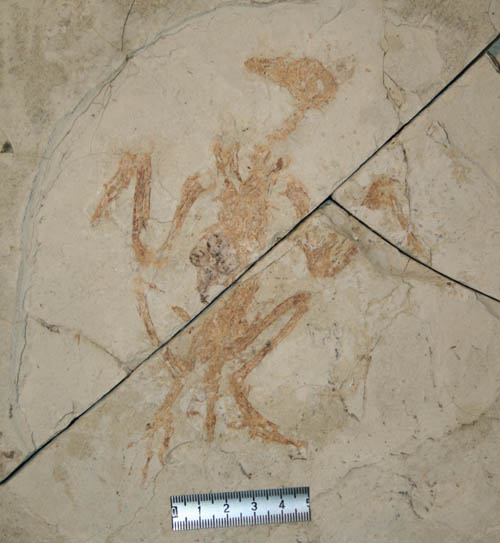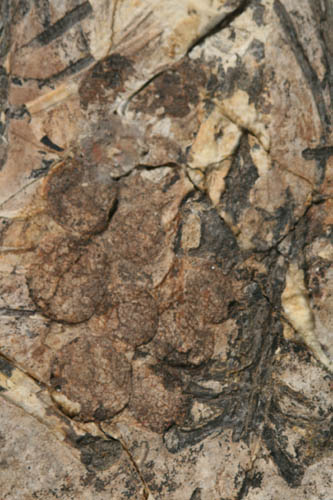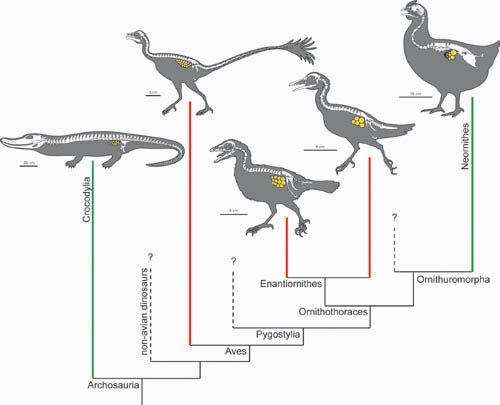| Location: Home > Research > Research Progress |
| First Discovery of Fossilized Ovaries Reveals Early Evolution of Avian Reproduction |
|
In an article published online March 17 in Nature, researchers from the Institute of Vertebrate Paleontology and Paleoanthropology (IVPP), Chinese Academy of Sciences, and the Shandong Tianyu Museum of Natural History described three specimens of fossil bird from the Early Cretaceous Jehol Group which preserved the remains of mature ovarian follicles in their abdominal cavity. This is the first discovery of the preserved soft tissue of reproductive organs in a fossil tetrapod. The three fossils record a wide phylogenetic bracket within Aves, preserved in one specimen of the long boney-tailed birdJeholornis, the second oldest and most primitive fossil bird (after Archaeopteryx), and two enantiornithines – sister taxon to Ornithuromorpha, the group that includes living birds. Comparisons in ovarian morphology betweenJeholornisand Enantiornithes reveals an evolutionary gradient from the non-avian dinosaurian condition towards that of modern birds; differences between the enantiornithines themselves indicates that this diverse clade evolved further specialization of the reproductive system in parallel to modern birds. Living archosaurs crocodilians and birds differ greatly in their reproductive strategy; these specializations in Aves evolved during their evolution from dinosaurs. Crocodilians have two ovaries, as do all known dinosaurs, while living birds have only one. All fossil bird specimens preserve only the left ovary, as in living birds. Jeholornis is one of the most basal birds known, indicating that the right ovary was lost very close to the dinosaur-avian transition. This confirms hypotheses that the right ovary was lost in order to reduce weight in flight. The difference in size of the ovarian follicles in each specimen records an evolutionary gradient from the large clutches of smaller eggs present in crocodilians and non-avian dinosaurs to the smaller clutches of large eggs present in living birds. The morphology of the ovarian follicles indicates that the yolks grew more slowly than those in living birds, consistent with the lower metabolic rate determined for Mesozoic birds through histological analyses that shows bone was deposited more slowly. Living birds grow very quickly and reach skeletal maturity before they become reproductively active. Histological analyses of these new specimens show that, like non-avian dinosaurs, basal birds became sexually mature before adulthood. “It took us a while to figure out what these strange circular structures actually represent,” said Dr. ZHOU Zhonghe, project leader of the IVPP . The small structures might possibly have been seeds or tiny stones the birds had swallowed to grind food in their digestive system. But on the basis of the size, shape, and position of the rounded structures, the team ruled out the alternative explanations and interpreted them as ovarian follicles. “These fossils are incredible, we may never have another discovery like it,” said author Dr. Jingmai O’Connor from the IVPP, “They answer many important questions regarding the evolution modern avian reproduction. The biological insights provided by fossils from the Jehol are unparalleled.” The fossils furnish information about the reproductive habits of these animals. In one of the birds, some of the bones in the creature's wing weren't fully fused, Zhou said. That suggests that the creature wasn't an adult, hinting that females of its species became sexually mature before they were fully grown. The new findings "are very exciting," said Frankie Jackson, a vertebrate paleontologist at Montana State University, Bozeman. Besides revealing that even early birds had reproductive biology significantly different from that of their closest dinosaur kin, they provide a new approach to estimate the brood size and the onset of sexual maturity in adults. These reproductive traits—including the loss of one of the ovaries, which probably would have rendered egg-laden females significantly lighter—likely had a substantial impact on the evolution of flight. That development may even have helped some bird lineages survive the mass extinctions in the wake of an asteroid impact that claimed the dinosaurs 65 million years ago. The research was supported by the National Basic Research Program of China, the National Natural Science Foundation of China and the Chinese Academy of Sciences.
Fig.1 One of two enantiornithine with fossilized ovarian follicles (Image by ZHOU Zhonghe)
Fig.2 Close-up of fossilized ovarian follicles in one of two enantiornithine. (Image by ZHOU Zhonghe) Fig.3 The evolutionary gradient from crocodilians to living birds. (Image by SHI Aijuan) |


